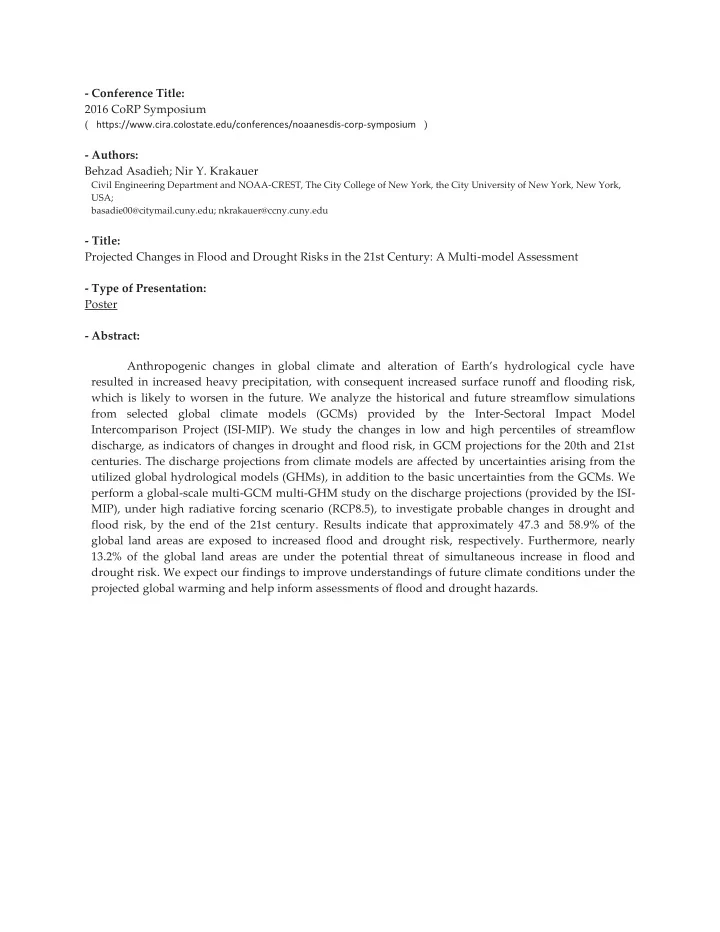

- Conference Title: 2016 CoRP Symposium ( https://www.cira.colostate.edu/conferences/noaanesdis-corp-symposium ) - Authors: Behzad Asadieh; Nir Y. Krakauer Civil Engineering Department and NOAA-CREST, The City College of New York, the City University of New York, New York, USA; basadie00@citymail.cuny.edu; nkrakauer@ccny.cuny.edu - Title: Projected Changes in Flood and Drought Risks in the 21st Century: A Multi-model Assessment - Type of Presentation: Poster - Abstract: Anthropogenic changes in global climate and alteration of Earth’s hydrological cycle have resulted in increased heavy precipitation, with consequent increased surface runoff and flooding risk, which is likely to worsen in the future. We analyze the historical and future streamflow simulations from selected global climate models (GCMs) provided by the Inter-Sectoral Impact Model Intercomparison Project (ISI-MIP). We study the changes in low and high percentiles of streamflow discharge, as indicators of changes in drought and flood risk, in GCM projections for the 20th and 21st centuries. The discharge projections from climate models are affected by uncertainties arising from the utilized global hydrological models (GHMs), in addition to the basic uncertainties from the GCMs. We perform a global-scale multi-GCM multi-GHM study on the discharge projections (provided by the ISI- MIP), under high radiative forcing scenario (RCP8.5), to investigate probable changes in drought and flood risk, by the end of the 21st century. Results indicate that approximately 47.3 and 58.9% of the global land areas are exposed to increased flood and drought risk, respectively. Furthermore, nearly 13.2% of the global land areas are under the potential threat of simultaneous increase in flood and drought risk. We expect our findings to improve understandings of future climate conditions under the projected global warming and help inform assessments of flood and drought hazards.
Projected Changes in Flood and Drought Risks Under Climate Change in the 21st Century: A Multi-GCM Multi-GHM Approach Behzad Asadieh Ph.D. Candidate of Civil Engineering – Water Resources City College of New York, City University of New York (basadie00@citymail.cuny.edu) Study Overview: � Changes in Flood and Drought in 21C compared to 20C � RCP2.6 and RCP8.5 Scenarios � Study the changes in High and Low streamflow percentiles (95th and 5th) � Using 5 GCMs and 5 GHMs (Total 25 dataset) � Study the population affected by increase in Flood, Drought, or both
Comparison of results of polarimetric imaging and radiative transfer modeling of the atmosphere-ocean system Carlos Carrizo, Anna McGilloway Ahmed El-Hasashi, Robert Foster, Matteo Ottaviani, Alex Gilerson Optical Remote Sensing Laboratory The City College of the City University of New York, New York, NY 10031, USA Quantitative polarimetric imaging of the sky and ocean surfaces can drastically improve the knowledge of the remote sensing of the atmosphere and the retrieval of water parameters because of the obvious increase in information content carried in such measurement. However, technological difficulties have long challenged the design and assembly of polarimetric instruments capable of measuring a scene’s Stokes vector with satisfactory accuracy. In addition to this, deploying such instruments (i.e.: polarization camera) in the field is often critical due to the rough environment to which they are exposed as well as the significant uncertainties in orientation from unstable platforms such ships. We present results from the calibration technique adopted for the commercially available, full-Stokes polarimetric camera (SALSA , Bossa Nova Technologies), together with the analysis of measurements acquired in the lab, and in the field on different ocean-water types. The images are validated against simultaneous and co-located measurements by a hyperspectral radiometric polarimeter (HyperSAS-POL). Camera measurements of the sky and the water surface for various viewing angles and atmospheric and oceanic conditions were successfully matched with results of modeling using a vector radiative transfer code for the atmosphere-ocean system.
Recommend
More recommend